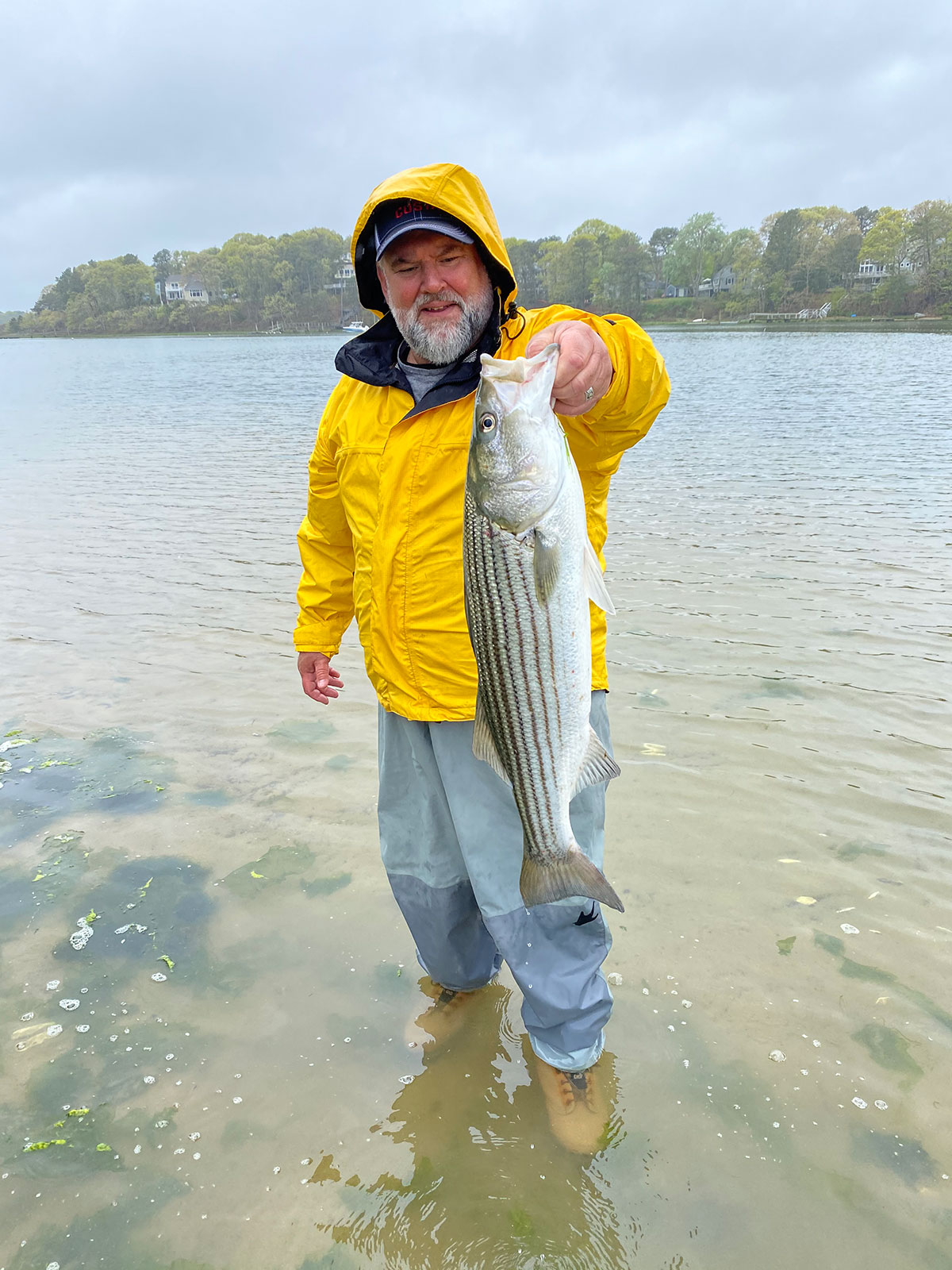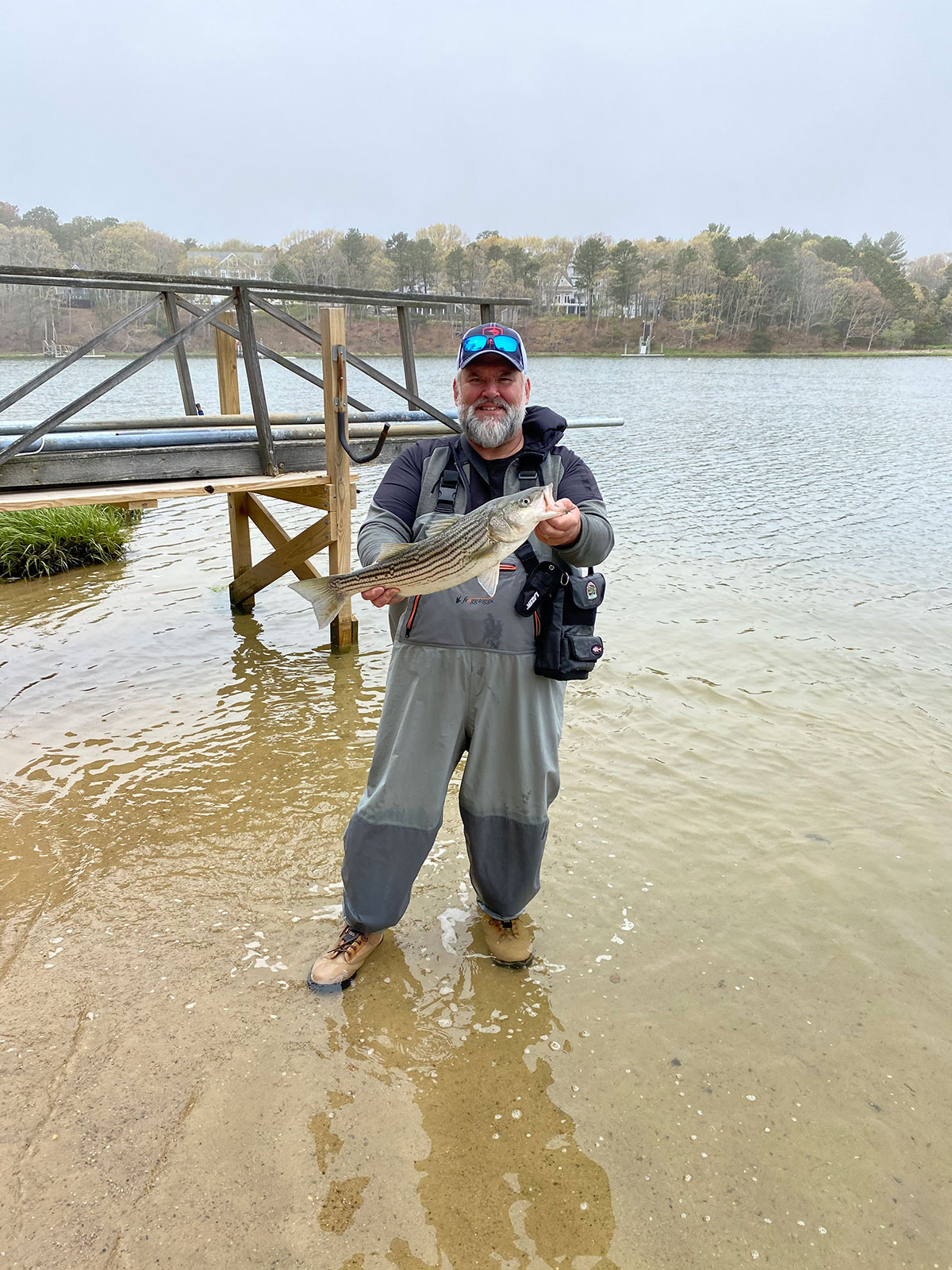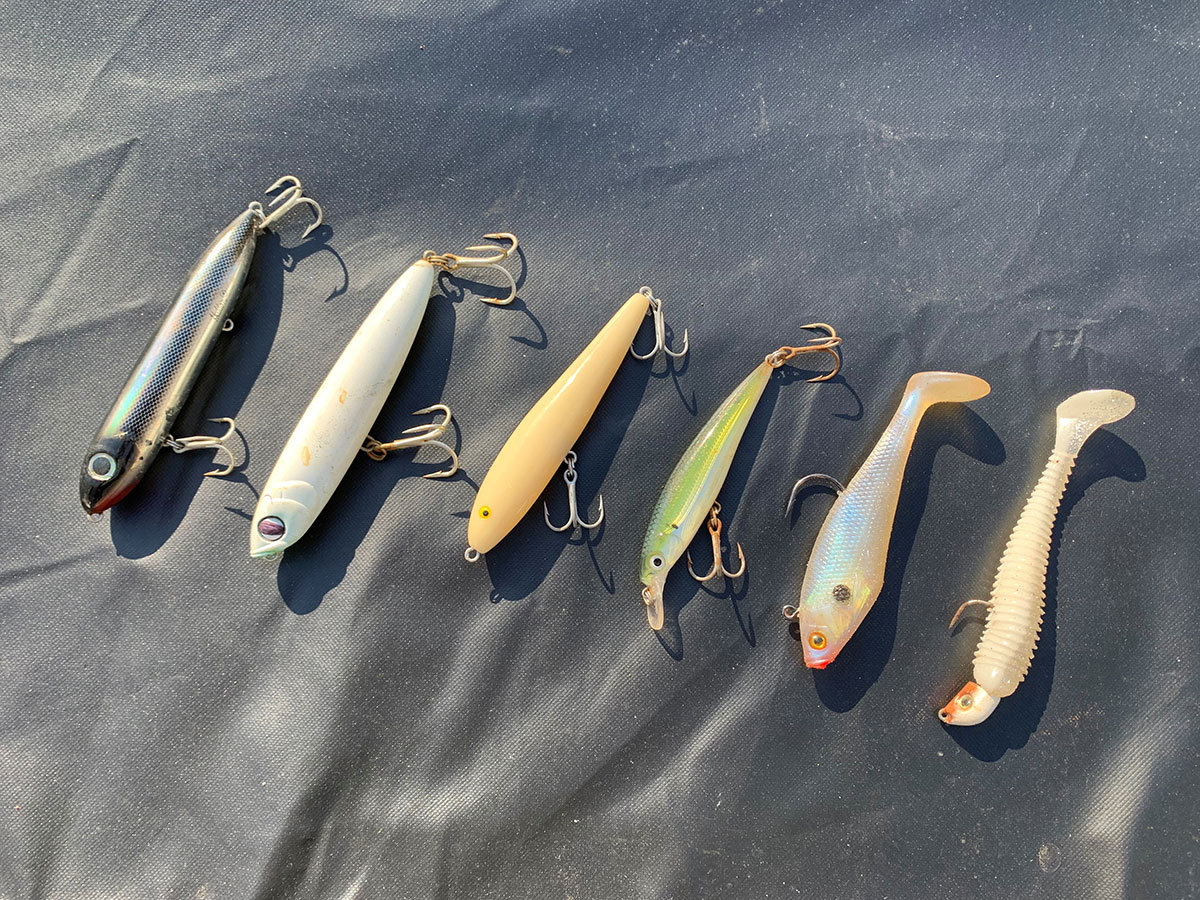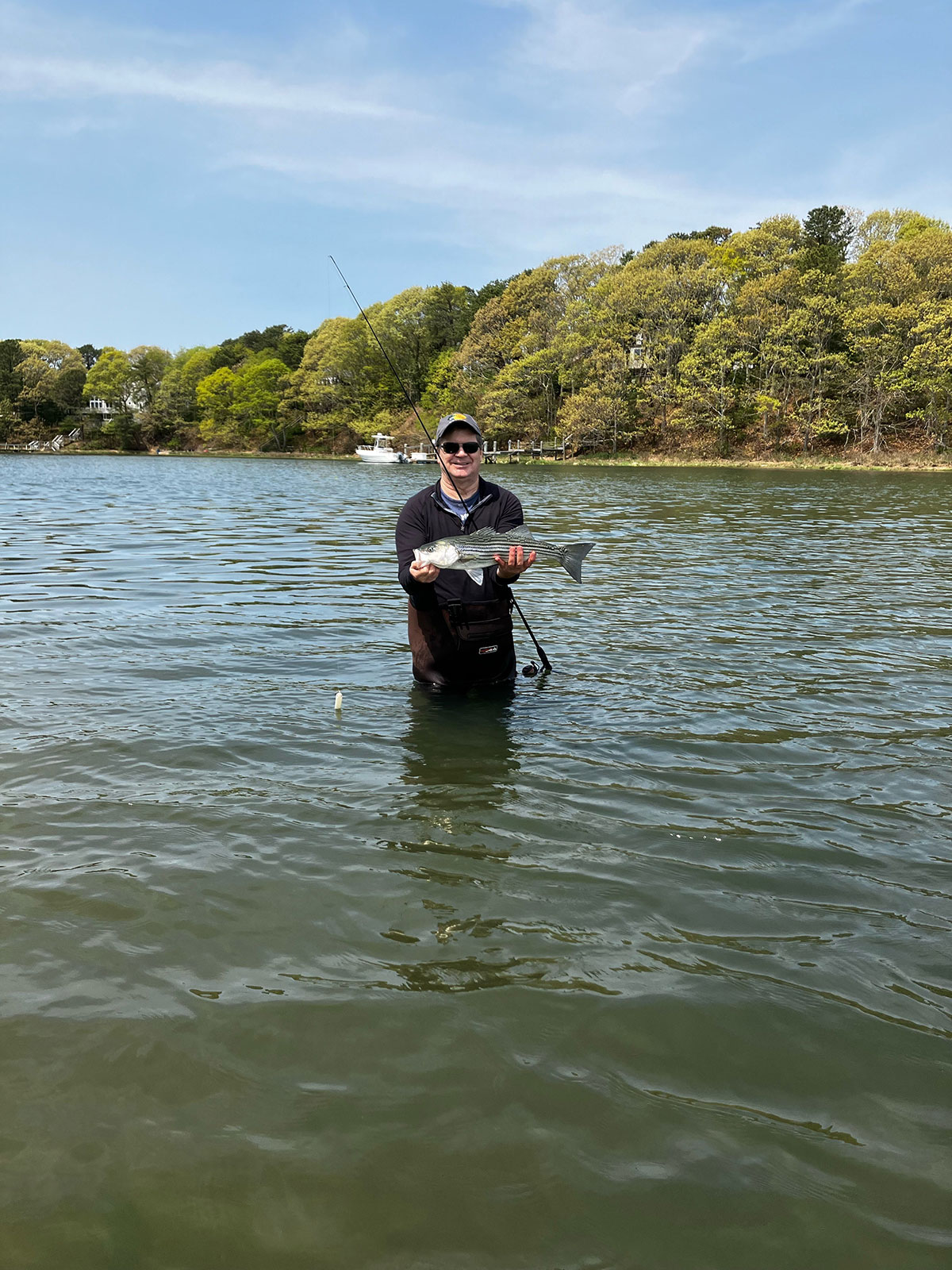
Backwater bassin’ for the springtime surfcaster.
Here in New England, springtime basically arrives with a warming tease, a hint of summer, budding trees, opening day at Fenway Park, and sunsets after dinnertime. But spring also brings seasonal visitors to our shores and estuaries. River herring are instinctually drawn to the coastal streams and rivers of their birth to spawn; and by mid-to-late April the waters are teeming with fish.
By the time the herring are dimpling the surface of the salt ponds and inner bays, anglers who have been anxiously awaiting their arrival since the end of “fishing show season” (aka late winter) are locked and loaded for the start of another fishing season. These fishermen know that some weeks after the herring arrive, striped bass will be in hot pursuit, following their own migration from points south, such as the Chesapeake Bay and the Hudson River. Holdover stripers will soon be joined by hungry, school-sized bass. April can provide some fast action, especially for the surfcaster exploring our warm inshore waters.

The First Run
The morning greeted me with sparkling blue skies, a slight nip to the air, and a forecast for temps in the upper 50s by midday. The swirl of steam from my coffee cup was not so much a result of the chill, but more a gentle warning about the mouth-scorching temperature of a fresh Dunkin’ medium cup o’ Joe. It was a beautiful day, and my first real trip of the season. The herring runs had been loaded for a couple of weeks; and the reports of fresh striped bass were trickling in over the surfcaster’s telegraph.
The following morning, I loaded up the truck with my springtime arsenal. A handful of tins and Kastmasters, small plastic shad patterns, and topwater plugs. The warmth of the sun on my face belied the temperature that would greet my lower extremities, as I worked my way down the shoreline of a barrier beachfront. I silently thanked myself for the extra layers and long-johns I donned before leaving the house, as I waded in the water off a slight point which I knew held structure favored by early season bass. A 1-ounce Kastmaster was first out of the surf bag, and now hung from my leader, dangling from the tip of my 8-foot surf rod. Rearing back, I let fly just past the hidden structure and began a steady retrieve. After multiple casts, fanning the entire area, I continued my trek down the beach, prospecting for any hungry bass that may be cruising the gentle surf.
An hour later, and I was still searching for my first fish. By that point, I had already conceded that the last two days of weather, which included a cold, steady rain, had undoubtedly been a shock to the beaches. With the sun moving higher in the sky, the air temps were climbing; but it would take some time to get those ocean waters warmed up and get those fish moving. However, the salt ponds and back bays were approaching high tide; and with shallower water and dark bottoms, I was hoping the water temperature would be much more to the fish’s liking. It was time to make a move.

In The Back
After a short drive inland, I pulled over onto the small roadside lot, tucked away in a somewhat secluded neighborhood. I could see one of the coves that made up part of this expansive inland bay system; but its locale, and the fact that there were no obvious beaches or noticeable attractions to tourists made this spot special. Especially for the angler who knows how to do some reconnaissance with a map. From overhead, an angler would see what would make a destination like this worth checking out. While I expected the water to be warmer in all of these upper bay areas, a little homework will help pinpoint where to target your efforts. Points, bottlenecks, and areas where there would be an increase in current are ideal places to start, shuttling bait and predators in pursuit.
This little roadside spot, harbored an overgrown path which led to just such a spot. As soon as I felt the pressure of the water closing around my shins, the increase in water temperature was immediately obvious. In the distance, my eyes following the shore towards the point on one side of the bottleneck identified, baitfish, herring specifically, splashing atop the otherwise calm waters. As I neared the point, a larger splash would occasionally echo across the ripples.
A slight disturbance off to my right, still some 200 feet away from the point, caught my attention. This area was more a muddy, tidal flat, perfect for the 1-ounce chrome spook I had already tied on. My cast landed exactly in the fading ripples, and I began a steady walk-the-dog retrieve. In a matter of seconds, the postcard background and the serenity of the blue skies reflecting off the water’s surface was interrupted by a savage strike from a striper. The hit sent my lure three feet into the air before crashing down again, and as soon as I righted the plug, it was taken down. After a determined fight, I released my first striped bass of the spring, a striking, purple-hued, 20-inch schoolie, adorned with sea-lice, indicating it was a recent arrival from points south.

Who Let The Dogs Out?
I continued working this stretch as I made my way toward the point, although no further hookups would follow that first. Upon arriving at the point, the fish which appeared quite active, seemed to have contracted a case of lockjaw. Over my shoulder, my good friend Mark was in my tracks, joining me in our early-season schoolie quest. Mark had introduced me to this particular spot, and had it dialed in, and with that, he tossed me a Rebel Jumpin’ Minnow.
Before I had a chance to swap out my larger spook for the Jumpin’ Minnow, Mark was calling out, hooked up to a bass. Before Mark had a chance to release his fish, we were doubled up, as I made fast work typing on the plug and had it dancing in seconds before another schoolie found the hook. The next couple of hours featured topwater explosions, numerous hookups, a swing and a miss here and there, and periods of experimentation with other topwater offerings. The Jumpin’ Minnow accounted for most of the hookups, but the old reliable Zara Spook recorded one more fish later in the ebb tide.
In addition to the aforementioned plugs, a new entry into my topwater collection, the Yo-Zuri Top Knock Pencil, proved itself worthy to be included in my spring surf bag; and I’m looking forward to tossing it in these back waters, come spring. But, with the days getting longer, as the season approaches, I’m also planning on exploring other hidden coves, where the warmer water temperatures just might unearth another springtime tradition. Winter is gone and the bass are moving in… I’ll see you in the suds!




